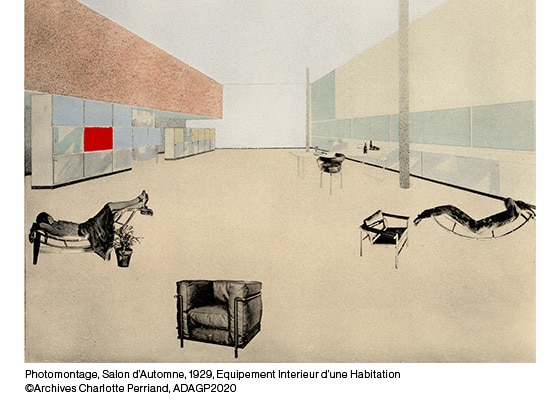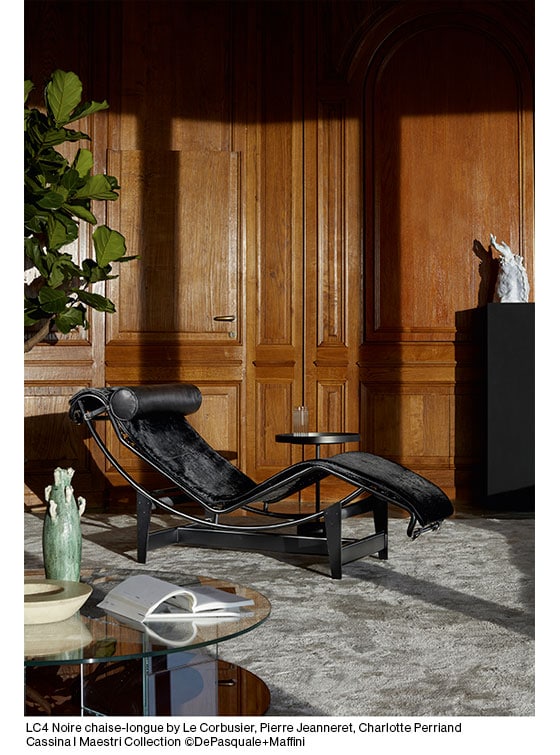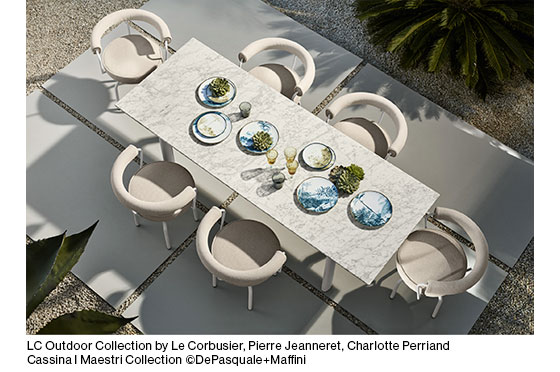Cassina is a community. A community of people all over the world passionate about design.
During this moment of uncertainty, many of us are confined to our homes trying to face a situation that we would never have imagined.
To support our community at this difficult time, we would like to stay close and continue to share inspiring content to transmit the values upon which we have always prided ourselves by.
We would like to take your minds on a journey through Italian creativity to discover the heritage behind a selection of projects that have shaped the history of contemporary design.
#1 LC Collection by Le Corbusier, Pierre Jeanneret, Charlotte Perriand: Cassina I Maestri Collection

A scandalous debut for contemporary design
The Salon d’Automne, the annual art exhibition held at the Grand Palais in Paris, was the staging for the Equipement intérieur d’une habitation by Le Corbusier, Pierre Jeanneret and Charlotte Perriand, in 1929. This was the trio’s first public presentation of the iconic tubular metal furniture, at the time received with much scandal due to its unexpected and criticised minimalism.

A fascinating story of encounters and know-how
In 1964, while Le Corbusier and the co-authors were still alive, Cassina signed the contract to start producing the first four models by Le Corbusier, Pierre Jeanneret e Charlotte Perriand, employing a philological process which marked the very beginning of the Cassina I Maestri Collection.
By choosing Cassina, Le Corbusier demonstrated great international recognition of the industrial know-how of the Italian company. Cassina immediately accepted the challenge to produce these revolutionary items, unfamiliar at the time, introducing over the years a series of technical innovations to advance the products from a small artisanal production to an industrial manufacturing process.
Thanks to the collection’s commercial success, which went hand in hand with the internationalisation of the company, these products produced in Meda were distributed worldwide, making them the familiar icons that they have become today.
Le Corbusier 50 is a fascinating story that retraces the life of the renowned architect and the meetings which led to the production of the LC Collection.
Thanks to this story, which in parallel, recounts the worldwide diffusion of Italian style, it is possible to understand the true value of the production and the international distribution of these modern icons.
The 52 minute documentary underlines the importance of the research and innovation carried out by the Italian industry and is enriched with a series of testimonies of important architects, designers, historians and experts, from Richard Meier and Philippe Starck, to Karl Lagerfeld and Jean-Louis Cohen, as well as historical iconographic and video material provided by the Le Corbusier Foundation and the heirs of the co-authors.

Authenticity first
Cassina is the only authorised company to produce designs by Le Corbusier, Pierre Jeanneret, Charlotte Perriand, working in close collaboration with the Le Corbusier Foundation and the heirs of the co-authors.
Right from the very beginning, the models were branded with a progressive production number, an innovative tool to recognise the artistic value of the pieces and to ensure control of the original production.
Today, it is always more vital to fight against imitations and protect the culture of design as an important historic and cultural heritage in order to sustain innovation and quality.
Cassina’s commitment is to pro-actively develop the LC Collection with product innovation and cultural initiatives to put the copycats in a difficult position where they are unable to contend with the high quality and content of the projects.

An evolving collection
The LC Collection is not frozen in time. Thanks to the close and constant collaboration with the Le Corbusier Foundation and heirs of the co-authors, the collection continues to expand making available a complete collection of furniture that represents modernity while responding to today’s necessities.
The first models of tubular furniture were not produced in the standard black leather and chrome versions that we all associate to these icons today (black and white photographs have perhaps fooled us into thinking this!), they were often personalised and with a distinctive use of colour.
The interiors of some of Le Corbusier’s custom projects, such as Villa Church, were designed with Pierre Jeanneret and Charlotte Perriand who adapted the details and features of the various furnishings to suit the context of the space. This important relation between architecture, interiors and furniture – also a fundamental factor for Cassina today – is particularly recognisable in the non-standard use of colour and constructive details.

Le Corbusier, Pierre Jeanneret and Charlotte Perriand were all particularly conscious about the importance of the environment and nature was often a central theme in their works. They had a joint mission to restore the
connection between nature and mankind in architecture and urbanism.
“My childhood years were spent with my classmates amongst nature. […] I knew flowers inside out, the shapes and colours of birds, how a tree grows and how it balances even in the eye of a storm. The tree, man’s friend, a symbol of all organic creation; the tree, the image of a complete construction”.
Le Corbusier, The Decorative Art of Today, 1st ed. Paris, G. Crès, coll. “The New Spirit”, 1925, Réed. Paris, Flammarion, 1996, p.198
Today the LC Collection has been relaunched as part of Cassina’s complete Outdoor Collection. Its new range of fabrics and finishes boast both aesthetics and quality that are equally comparable to those for indoor use.
Take a peak at the LC Outdoor Collection video
As part of its ongoing quest for innovation, Cassina has carried out a series of upgrades on the LC Collection.
For the collection’s 50th anniversary celebrated in 2015, the industrial process adopted by its suppliers in the production and disposal of chromium plated frames was completely reviewed.
The use of hexavalent chromium, a method still implemented by the furniture industry to protect from metal corrosion and increase aesthetics, is destined to become obsolete as the automobile industry has anticipated.
Hexavalent chrome plating chemicals can be carcinogenic when inhaled during the production cycle due to the hazardous waste created.
This is why Cassina made a conscientious decision to only employ a trivalent chromium plating process for the product frames, a safe and considerably less toxic alternative thanks to lower chromium concentration levels, less air emissions and consequently less toxic waste.
Further innovation regarding sustainable materials will be revealed as part of the 2020 Collection launch
